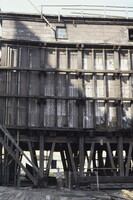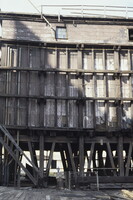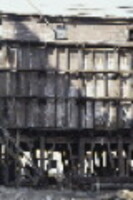| dc.description | Lincoln Wharf is a 191-unit condominium on the waterfront in Boston’s historic North End. The wharf itself, originally named Lincoln’s Wharf, dates back to the late 1700s. It is next to Battery Wharf, from which British soldiers rowed across Boston Harbor to Charlestown on June 17, 1775 to fight the Battle of Bunker Hill.
Adjacent to Battery Wharf is the Boston Coast Guard Station. Here, the USS Constitution was built at what was then Edmund Hartt’s shipyard. Launched on October 21, 1797, the ship led a U.S. squadron that conquered Tripoli, putting a halt to the North African Barbary pirates’ nefarious attacks on American merchant ships and enslavement of American sailors. The ship won the nickname “Old Ironsides” in a battle in the War of 1812. The three-masted frigate, the world’s oldest commissioned naval warship afloat, is based at the Charlestown Navy Yard. Residents of Lincoln Wharf are treated to a thrilling sight as this beautifully maintained U.S. Navy ship -- a ship that never lost a battle -- is sailed past the building every Fourth of July and on other holidays.
After some 100 years as a general wharf and as a dock for ships that carried thousands of immigrants from Canada, Lincoln Wharf was selected as the site for a coal-fired electric power plant, needed for the new Boston Street Railway. The power plant, built on tidal fill and supported by 12,000 wooden pilings, went into operation in 1901. A large shed at water’s edge stored coal brought in by ship. The plant’s two tall brick smokestacks were a landmark along the Boston waterfront. The Sumner Tunnel, built later to connect the North End to East Boston, runs partly beneath the wharf. The power plant operated until the mid-1970s.
In the early 1980s, developers acquired the building from the MBTA, the Massachusetts Bay Transportation Authority, to convert it into a condominium, known formally as the San Marco/Lincoln Wharf Condominium Trust. As part of the development agreement, about one-quarter of the units were sold as “affordable” while the rest were sold at market prices. The development project involved removal of the huge boilers and electric power generators, removal of the coal bins, and the demolition of the tall smokestacks. This project, like much in the North End, was historic: it was America's first conversion of a power plant into residential use.
The renovation of the handsome 10-story brick building was completed in the late 1980s, and all units were sold by 1990. The building features a dramatic inner atrium. The exterior brickwork is of a classic pattern used for public structures in the late 1800s and early 1900s. A 10-foot-tall copper eagle is a proud symbol on the front of the building, at the roofline. Depending on which side they face, units offer fine views: Boston Harbor, the South Boston waterfront, the financial district and downtown skyline, East Boston, Charlestown and the Navy Yard, “Old Ironsides”, the new Leonard Zakim-Bunker Hill Memorial Bridge, the old Tobin Bridge over Mystic River, the inner harbor, TD Garden, and the Old North Church.
Burroughs Wharf, a condominium, was built on a wharf between Lincoln Wharf and Battery Wharf shortly after the power plant’s conversion to condos was complete.
Battery Wharf, following a $300 million construction project completed in 2009, is now home to the 150-room Fairmont Battery Hotel, 104 condominiums, the Sensing Restaurant, the Boston Maritime Museum, and commercial space. | en_US |



